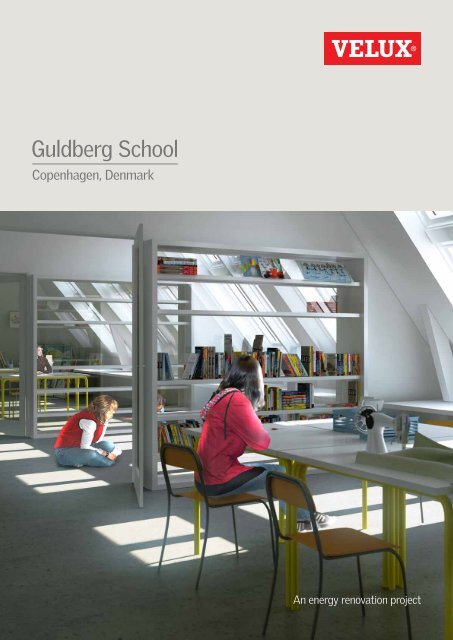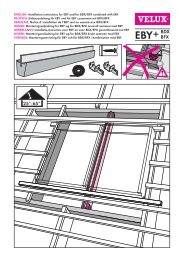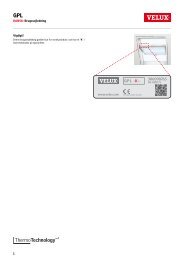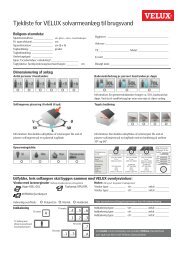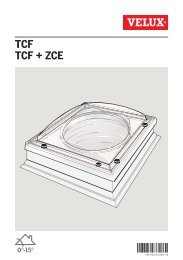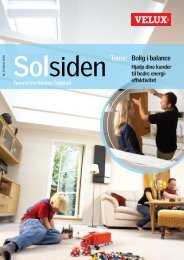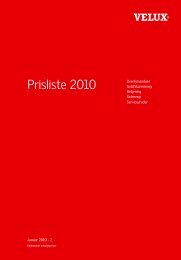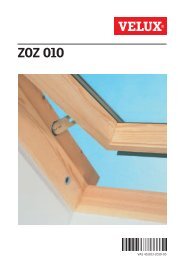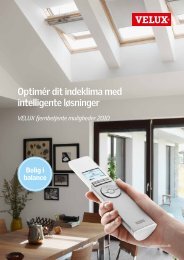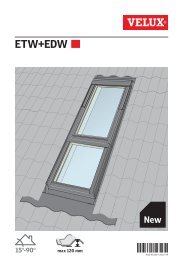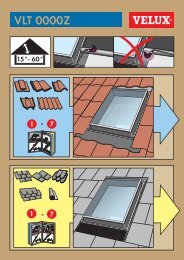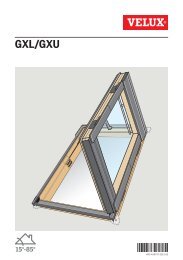Guldberg School - Velux
Guldberg School - Velux
Guldberg School - Velux
- No tags were found...
You also want an ePaper? Increase the reach of your titles
YUMPU automatically turns print PDFs into web optimized ePapers that Google loves.
The ChallengeThe City of Copenhagen has initiated strategic cooperationwith a number of Danish enterprises for the purpose ofmutual profiling on climate-friendly buildings.At the United Nations Climate ChangeConference 2009 - COP15 - in Copenhagen,the <strong>Guldberg</strong> <strong>School</strong> will host the participantsin the children's climate change forumand be visited by politicians and other participantsin the climate summit. The schoolwill show and communicate pedagogicalexperience and methods concerning lessonson climate and energy saving measures andbehaviour.Structural initiativesParallel with the pedagogical and teachingmeasures a number of construction initiativeshave been taken during 2009.E.g. VELUX roof windows and VELUX solarcollectors have been integrated in the roofand the pupils can follow the consumptionof electricity, water and heat on electronicmeasuring devices on a regular basis.VELUX 3
VELUX 5
Active HouseAn initiative supported by VELUXEnergyHealth&ComfortIndoor ClimateEnvironmentEnergy challengeis that buildings consume approximately40 % of all produced energy (Europeanfigures). Considering the total energy consumptionthroughout the whole life cycleof the building is an important tool in theconcern for climate changes, security ofsupply and for reducing global energy consumption.Indoor Climate challengeis that we spend 90 % of our time indoors,but less than 30 % of the building masscontributes to or provides a healthy indoorclimate. We humans need fresh air anddaylight when we are indoors. It has apositive effect on our health and well-beingas well as our ability to learn.Environment challengeis that although the challenges we face areglobal, the local environment differs greatly,and many present solutions are only viablewithin fixed parameters. We need anopen-minded approach to flexible solutionsthat take into account local cultural andinfrastructural differences.6 GULDBERG SCHOOL
An »Active House« meets the futuredemands for sustainable buildingsand has been developed with focuson health and comfort for the peopleliving in it.It has been designed to interact withlocal conditions and will to a wideextent use natural resources to makethe house CO 2 neutral.VELUX 7
Intelligent houses of the future will bedesigned to control the indoor climateautomatically; smart enough to knowwhen to insulate from cold, when toprotect from heat and when to provideventilation.8 GULDBERG SCHOOL
EnergyTo reduce CO 2 emissions and optimise energyperformance, the building must be consideredas a whole, not just the sum of itscomponents.Energy efficiency needs to be incorporatedinto the very design of the building, and theavailable natural resources, such as sun andair, should be exploited to a maximum.For instance, windows should be consideredas energy contributors. They should beplaced strategically to allow for solar heatgain and optimum natural ventilation.A flexible building envelope will preventoverheating and possible glare in peakperiods, so the VELUX roof windows havebeen fitted with electrically operated awningblinds, controlled either by the users orby the fully automatic control system NVAdvance from WindowMaster.VELUX solar collectors can generally provideup to 70% of the energy required toproduce domestic hot water. If solar thermalcollectors were installed in every home inEurope, the saving could amount to some20,000,000 tons of oil – equivalent to taking20 million cars off the road every singleyear. The sun is the most powerful source ofenergy we have and we should make maximumuse of it.VELUX solar collectors will be integrated inthe south facing roof area of the <strong>Guldberg</strong>school for production of hot water (+ heatingof the basement).Intelligent houses of the future will be designedto control the indoor climate automatically:smart enough to know when toinsulate from cold, when to protect fromheat and when to provide ventilation.Heat loss(U-value)Heat gain(g-value)Energybalance(Eref)VELUX 9
Indoor climateThe roof windows facing southMaximum daylight and ventilation are preconditionsfor ensuring optimal indoor comfortand minimal energy consumption consistentwith future standards.In a world with increasing health problems(partly due to e.g. the rising incidence ofallergies), the indoor climate is an essentialfactor to be considered when designing abuilding.Several studies prove that daylight hasa positive effect on health, productivity,children’s learning abilities and generalwell-being. Similarly, fresh air via naturalventilation is vital for producing a healthyindoor climate reducing the consequencesof toxic emissions from sources such aselectronic devices and chemicals in thebuilding – and thereby minimising the riskof allergies.Physical well-being, high productivity andlearning are related to a healthy indoor climate.Therefore, an optimal indoor climatefor pupils and teachers will always be worthwhile. For exemple, the Centre for IndoorClimate and Energy at The Technical Universityof Denmark has shown that pupils inpublic schools can acquire the same amountof knowledge in six years that they mustspend seven years learning today by optimisingthe indoor climate. The two most importantconditions precedent to a pleasantindoor climate is adequate ventilation and acomfortable room temperature.Automatic control of natural ventilationThe planned complete solution to naturalventilation and control of the room tempe-rature for the <strong>Guldberg</strong> school project isbased on the fully automatic control systemNV Advance from WindowMaster. It willmonitor all strategically placed VELUX roofwindows including sunscreening. Windowopening will be controlled automatically tooptimise the indoor climate proportional toindoor and outdoor temperatures and theuse of the building.Climate zonesThe building will be divided into three ventilationzones each with their own sensorsand parameters; the climate in the zoneswill be monitored individually accordingto wind direction, wind speed and air pressureon the façade as well as indoor andoutdoor temperatures and CO 2 -level. Theair pressure on the facades is calculated byCFD calculations carried out specifically forthis project. This will result in optimisationof the window openings according to 16 differentwind directions and is an importantpart of the control strategy.A calendar module controls ventilation accordingto the season (summer/winter) andtime of day (night, morning, daytime) andalso optimises the ventilation according tothe following ventilation methods:• Fresh air function – just before lessonsbegin in the morning or during scheduledbrakes, the building is ventilated so theair will feel fresh and pleasant.• Night cooling – efficient cooling of thethermal mass of the unused building atnight to avoid too high day temperaturesduring summer. The cooling of the buildingis adapted to the thermal load theday before.• Pulse ventilation – opening of windowsand closing shortly after to allow minimumair change in the building – especiallysuited for cold periods and to avoidheat loss.• Trickle ventilation – continuous airchange, especially suited for hot periodsand to create refreshing airflow.• User control – if the user wants to takecontrol of the ventilation, it is possible tooverrule the control system by switchesor the user interfaced NV Visual.• Safety function – in case of rain orstorm, windows will close for safetyreasons.Apart from precise control of the naturalventilation, other systems such as sunscreening,radiators, mechanical ventilatorsor light control can also be integrated intothe system to ensure optimal indoor climatewith minimal energy consumption. This isall controlled by the service module NVVisual, which enables change of parametersfor the system via the Internet. Everyzone is visualised in NV Visual, which alsoenables easy monitoring of the indoor climate,window openers, radiators etc.The three zones include monitoring of 14VELUX INTEGRA® roof windows with sunscreeningand the VELUX solar collectorsfor visualization of the output from the collectors.The educational effortThe climate issue will be part of the educationalwork and applied in both natural andsocial science lessons. The idea is to makethe pupils conscious about our mutual responsibilityof reducing energy consumptionand preventing serious climate changes andglobal warming.On the centrally placed touch screen and viaIP addresses the pupils can keep track ofmeasurements and they can see detailsabout the solar heat output, power consumptionand temperatures – as well as theCO 2 level.10GULDBERG SCHOOL
Daylight factorThe lowered existing roof windows with thenew smaller windows aboveDaylight Factor % Average: 2.7910.008.97.86.65.54.33.22.1The existing roof windowsDaylight Factor % Average: 2.2110.008.97.86.65.54.33.22.1FactsThe daylighting performance of the <strong>Guldberg</strong><strong>School</strong> has been specified using thedaylight factor (DF) as performance indicator.The daylight factor is a common and easyto-usemeasure for the available amountof daylight in a room. It expresses the percentageof daylight available inside, on awork plane, compared to the amount ofdaylight available outside the building underknown overcast sky conditions. Thehigher the DF, the more daylight is availablein the room. Rooms with an averageDF of 2% or more are considered daylit. Aroom will appear strongly daylit when theaverage DF is above 5%.The daylight factor analysis has been performedusing computer simulations of radiance.The figures on the left show thedaylight factor levels obtained for two differentvariants evaluating the impact ofthe installed roof windows on the finalizeddesign.The comparison of results shows the positiveeffects of adding roof windows on thedaylight conditions of the third floor. Itshows that the roof windows deliver highlevels of daylight in the centre part of theroom.The challenge in the rooms has been to get access to clear view, therefore, the existing windowshave been lowered and smaller windows have been installed above the existing ones forventilation purpose. Futhermore, the windows can be used as escape exits as required by theDanish Building Law.VELUX 11
EnvironmentArea renewalThe Ministry of the Interior and Social Affairsand the City of Copenhagen decidedthe area around the former Sjællandsgade<strong>School</strong> should be renewed in the periodfrom 2006 to 2010.The <strong>Guldberg</strong> <strong>School</strong> is a result of a mergingin 2006 of the schools located at Stevnsgadeand Sjællandsgade.The purpose of area renewal is to support apositive development in selected, problemstrickenareas, including to improve integrationand counteract ghetto forming in urbanareas. The efforts should contribute toputting an end to the areas’ negative trendwhere poor physical conditions, social problemsand a residential mix with no diversityinteract and aggravate each other.The aim of the project is to make the schooland the area around the school attractive,in particular to the ethnic Danes and wellto-doparents who have chosen or intend tochoose another school than the local publicschool.Citizen-controlled area renewalIt is crucial to a positive development of thearea renovation that it is embedded in thelocal area and controlled by the citizens.One of the challenges is to base the projecton the citizens’ visions through improvementsof the physical conditions in theneighbourhood of the school at Sjællandsgadeand thereby create a total lift of thearea.In 2008 the City of Copenhagen decided toappoint the <strong>Guldberg</strong> <strong>School</strong> as one of thespearheads of the City’s environmentalgoals and as demo project when the Citywould be hosting the UN Climate Summitin December 2009.The implemented environmental initiativeswill be relevant to the actual use of thebuilding and its location and status in thearea.FaçadeSectionVELUX solar collectors will be integratedinto the roof and the pupils will be ableto follow the consumption of electricity,water and heat on the electronic measuringdevices on a regular basis.VELUX 13
VELUX Productsused in the <strong>Guldberg</strong> <strong>School</strong>VELUX creates better homes with daylightand fresh air through the roof. Our productrange includes a variety of roof windowsand skylights, along with solutions for flatroofs. In addition, VELUX offers many typesof decoration and sunscreening products,roller shutters, installation products, productsfor remote control and thermal solarpanels for installation in roofs. The VELUXGroup, which has manufacturing companiesin 10 countries and sales companies in justunder 40 countries, is one of the strongestbrands in the global building materials sectorand its products are sold in most partsof the world.The Group has around 9,000 employees, ofwhich approx. 3,000 are based in Denmark.The VELUX Group is owned by VkR Holding.VkR Holding is a limited company whollyowned by family and foundations. The mainshareholders are the charitable VELUXfoundations. For more details, visitwww.velux.comWindowsVELUX roof windows. Pivot hung.Model GGL INTEGRA ® . Electrically operatedroof window including remote controland rain sensor for automatic closing incase of rain.VELUX roof windows. Pivot hung.Model GGL. Energy save.VELUX roof windows. Top hung.Model GPL. Energy save.Solar collectorsVELUX solar panels for hot water supply.Model CLI.Sunscreening productsExterior sunscreening - Electricallyoperated awning blinds. Model MML.Roof plan14 GULDBERG SCHOOL
The <strong>Guldberg</strong> <strong>School</strong>Copenhagen, DenmarkBuilding ownerCity of CopenhagenConsultantEKJ Rådgivende ingeniører ASArchitectNOVA5 arkitekter asGeneral contractorMT Højgaard A/SSuppliersWindowMaster A/SPartnersVELUX A/SThe VELUX Group is official sponsor of COP15.
VELUX A/SÅdalsvej 99DK-2970 HørsholmTel. +45 45 16 40 00www.velux.com1109 © 2009 VELUX Group. ® VELUX, THE VELUX LOGO AND io-homecontrol are REGISTERED trademarks used under licenCe by THE velUX Group.


